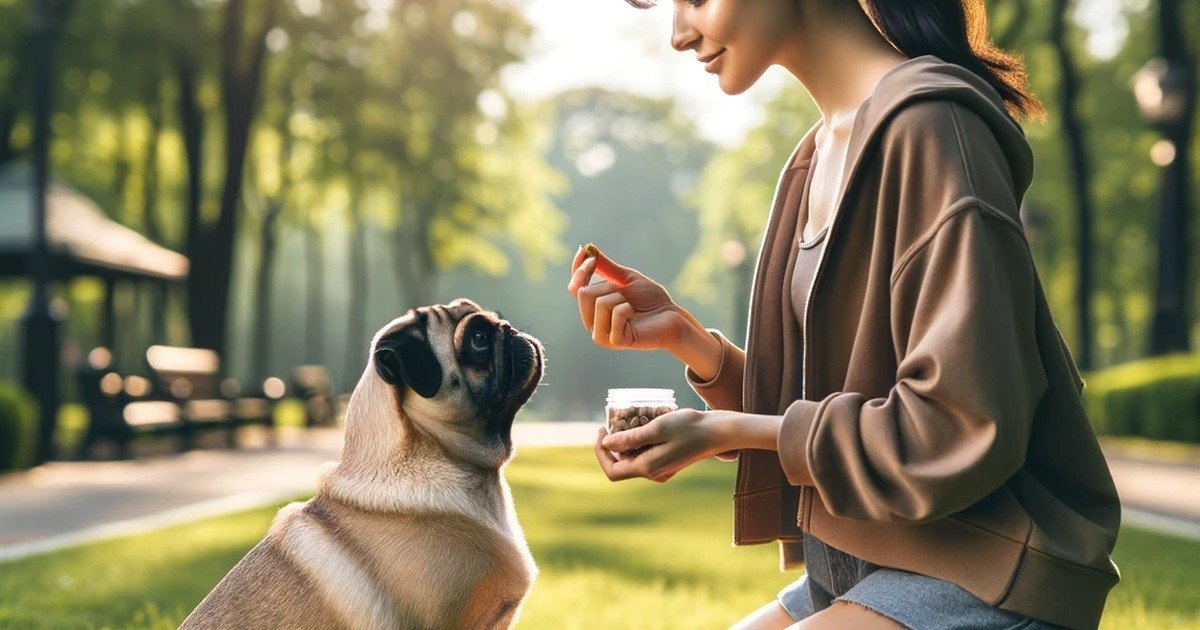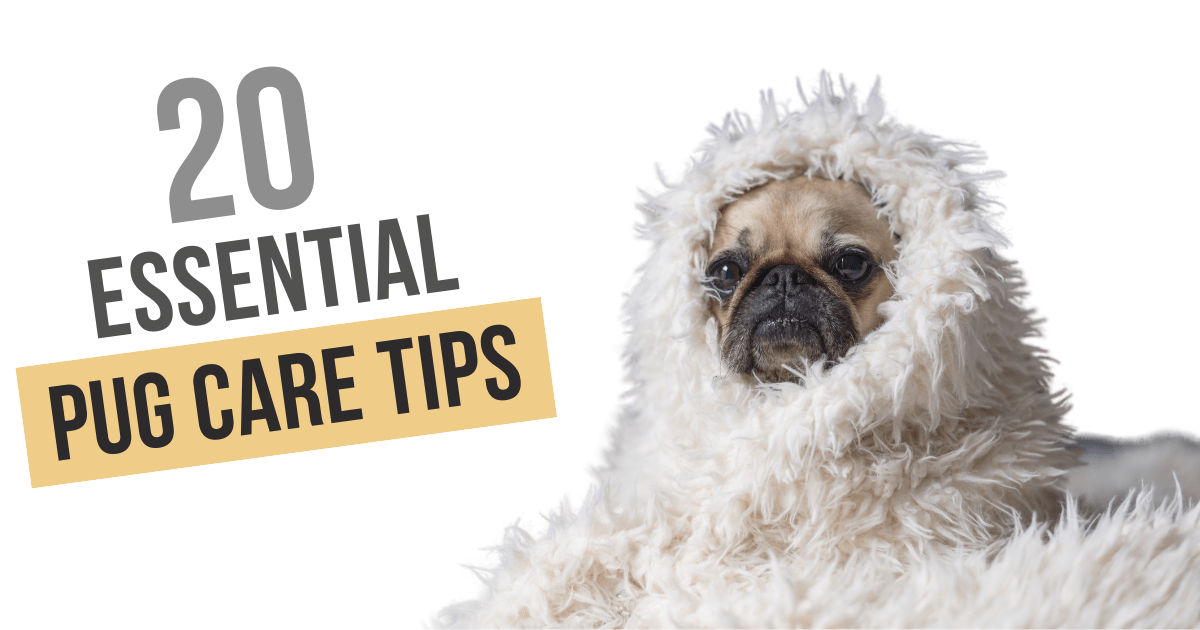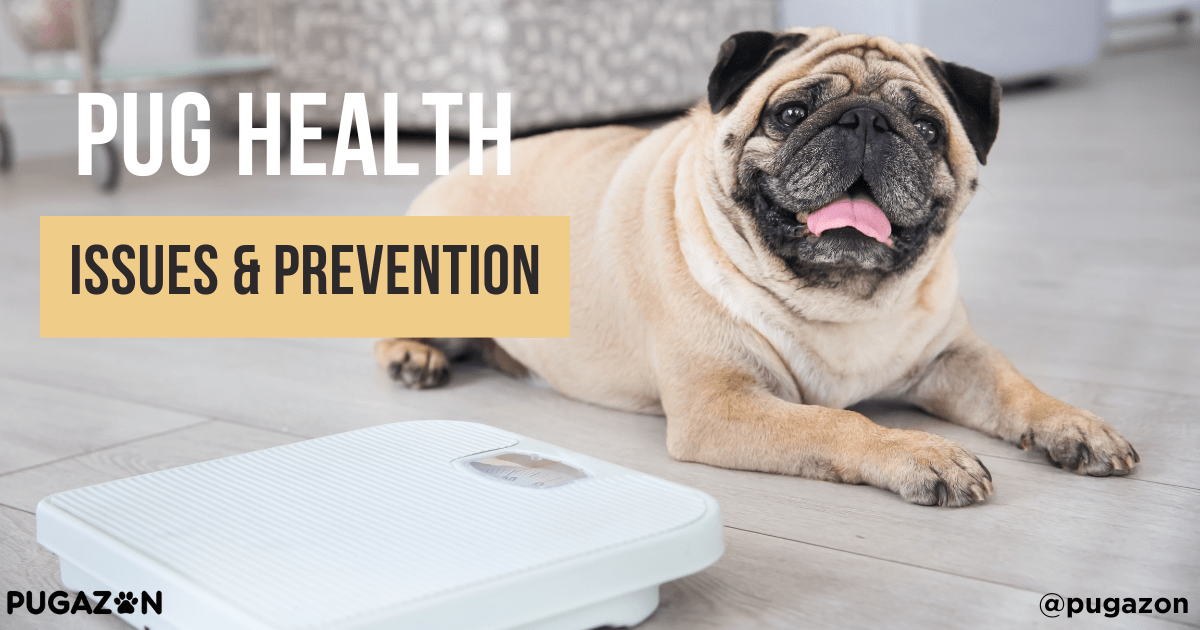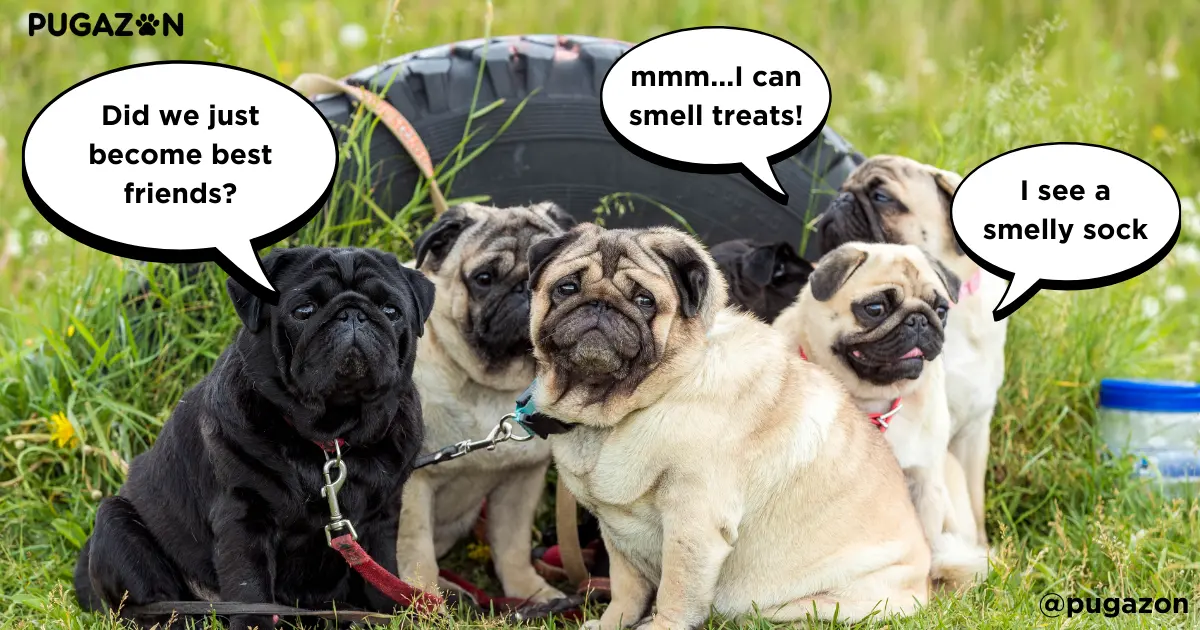The Joys and Challenges of Pug Training
Training a pug can be a delightful yet challenging experience for any dog owner. Pugs are known for their affectionate and playful personalities, but they also come with a stubborn streak that can make training a bit tricky. Their small size, coupled with their strong-willed nature, means that training requires patience, consistency, and a lot of positive reinforcement. However, once you understand their quirks and motivations, pugs can be trained effectively and even excel at advanced tricks.
Pugs are eager to please, but they also get easily distracted, often preferring play or cuddling over strict obedience. This can make basic commands like “sit” or “stay” a challenge at first. However, with the right approach, pugs can become obedient and well-mannered companions. They respond best to rewards and praise, making positive reinforcement the most effective method for teaching them new behaviors.
In this guide, we’ll explore how to train your pug using proven techniques and strategies. From basic commands to more advanced tricks, this comprehensive guide will equip you with the tools needed to unlock your pug’s full potential. Whether you’re dealing with a puppy, an adult pug, or even an older, more stubborn pug, there are steps you can take to ensure successful training.
Pug Training Basics: Positive Reinforcement Techniques
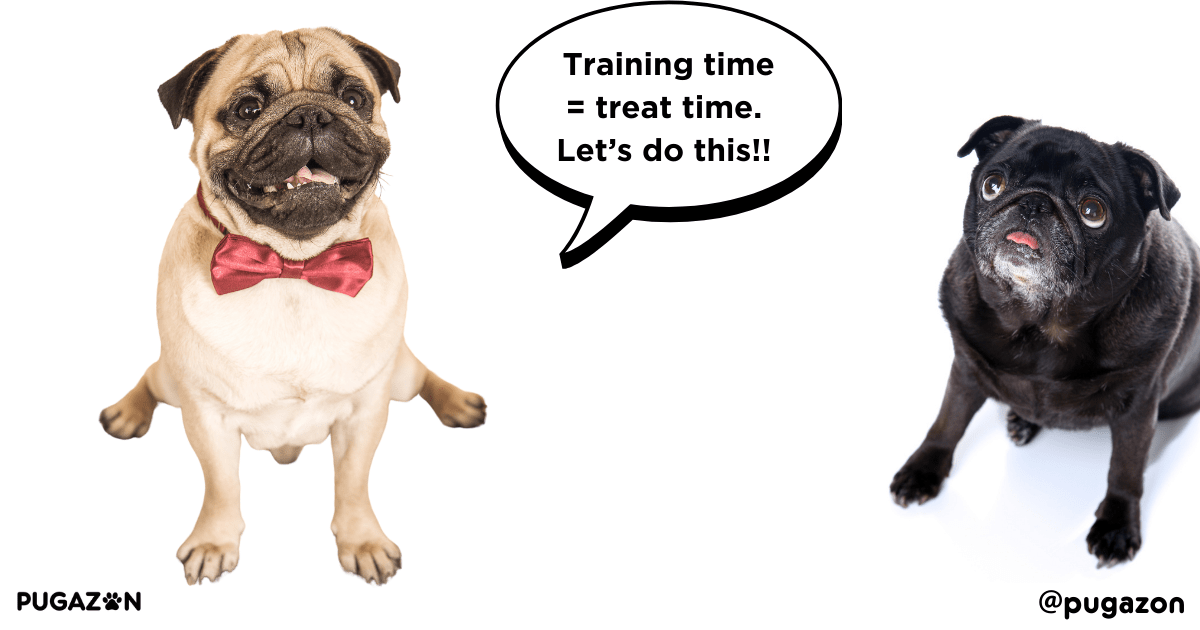
Positive reinforcement is the cornerstone of effective pug training. Pugs thrive on attention, praise, and treats, and they are much more responsive to rewards than punishment or corrections. Understanding how to apply positive reinforcement correctly will ensure that your pug learns quickly and enjoys the process.
Understanding Positive Reinforcement
Positive reinforcement means rewarding your pug immediately after they perform a desired behavior. This helps your pug associate the behavior with something pleasant, encouraging them to repeat it. The key to positive reinforcement is timing—your pug needs to understand which behavior is being rewarded.
- Example: If you’re teaching your pug to sit, you should give them a treat the moment their bottom touches the floor. Any delay could confuse them, making it harder for them to connect the action with the reward.
Using Treats and Praise in Pug Training
Pugs are highly food-motivated, which makes treats a powerful training tool. However, it’s important to use treats appropriately and avoid overfeeding. Break treats into small pieces to avoid excessive calorie intake and keep your pug motivated throughout the training session.
- Tip: Choose high-value treats—something your pug doesn’t get often but loves—to keep them interested in training. Pair treats with verbal praise like “good boy” or “good girl” to further reinforce the behavior.
Timing in Positive Reinforcement for Pug Training
The effectiveness of positive reinforcement depends on timing. If you reward your pug too late after the behavior, they might not understand what they’re being praised for.
Action | Reward Timing |
Pug sits | Give treat immediately when bottom touches floor. |
Pug comes when called | Reward as soon as your pug reaches you. |
Pug stays | Reward after they stay for the desired duration. |
Essential Commands for Pug Training Success
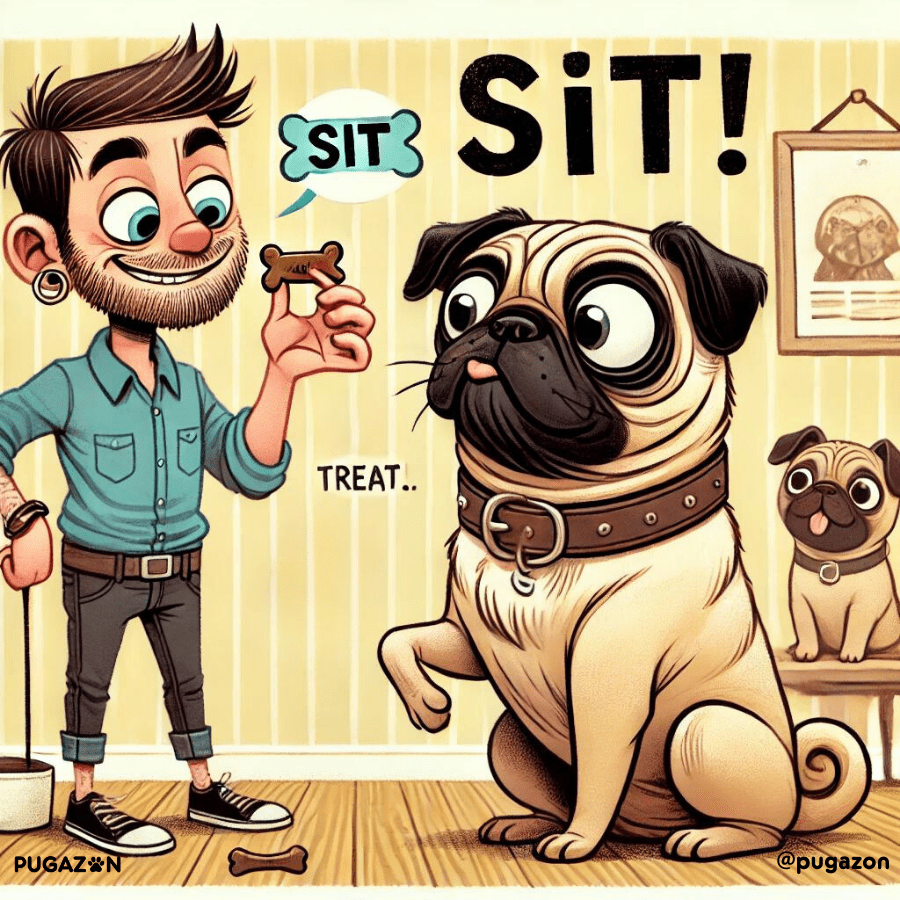
Training your pug to follow basic commands is the first step in creating a well-mannered and obedient dog. These essential commands will help you manage your pug’s behavior, both at home and in public spaces. Below are the most important commands every pug should know.
Teaching “Sit” in Pug Training
“Sit” is often the first command taught to dogs because it’s easy and serves as the foundation for other commands.
- Step 1: Hold a treat in front of your pug’s nose, then slowly move your hand upwards. As their head follows the treat, their bottom will naturally lower to the ground.
- Step 2: The moment their bottom touches the ground, say “sit” and give them the treat.
- Step 3: Repeat this several times until your pug understands the command.
Teaching “Stay” in Pug Training
Once your pug masters “sit,” the next step is teaching them to “stay.” This command is crucial for controlling your pug’s movements in busy or dangerous situations.
- Step 1: After your pug sits, open your palm in front of their face and say “stay.”
- Step 2: Take one step back. If your pug remains seated, give them a treat. Gradually increase the distance and duration of the “stay” command.
Teaching “Come” in Pug Training
“Come” is an essential recall command, especially for keeping your pug safe when off-leash or distracted.
- Step 1: Start in a quiet area with your pug on a leash. Say “come” while gently pulling on the leash.
- Step 2: When your pug reaches you, give them a treat and praise.
- Step 3: Practice this in different environments with more distractions as your pug improves.
Command | Teaching Process |
Sit | Use a treat to lure the pug into a sitting position. |
Stay | Pair a hand signal with verbal cues and practice distance. |
Come | Use a leash and rewards to reinforce the recall command. |
Understanding Pug Behavior for Effective Training
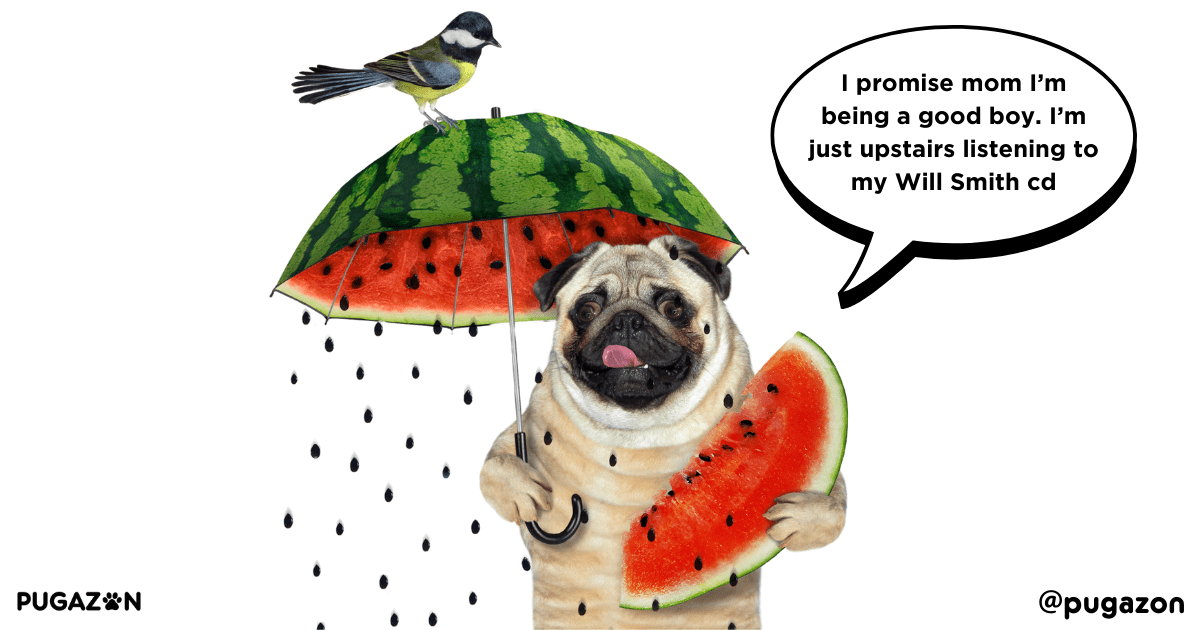
Pugs are unique dogs with their own quirks and personalities. Understanding their behavior is key to effective training. Pugs are intelligent but can be stubborn, and they are known for being playful yet sensitive. To successfully train a pug, it’s important to understand what drives their behavior and how to work with it.
Handling Stubbornness in Pug Training
Pugs are known for their stubborn streak. They may refuse to follow commands, especially if they don’t see an immediate benefit. This behavior can be frustrating, but it’s important to remain patient and consistent.
- Tip: Use high-value rewards and keep training sessions short to maintain your pug’s interest. Never force your pug into a behavior, as this can create resistance.
Using Energy and Playfulness in Pug Training
Pugs are naturally playful and have bursts of energy, making them eager to engage in games. However, their energy can also make it difficult to focus on training.
- Tip: Incorporate play into training sessions by turning commands into games. For example, practice “come” during a game of fetch.
Tone Sensitivity in Pug Training
Pugs are highly attuned to their owner’s voice and tone. Yelling or using harsh tones can make them anxious, which may hinder their training progress.
- Tip: Always use a calm, encouraging tone when training. Even when correcting behavior, remain positive to avoid stressing your pug.
Last update on 2025-02-11 / * Affiliate links / Image source: Amazon Product Advertising API
Pug Training for Specific Situations
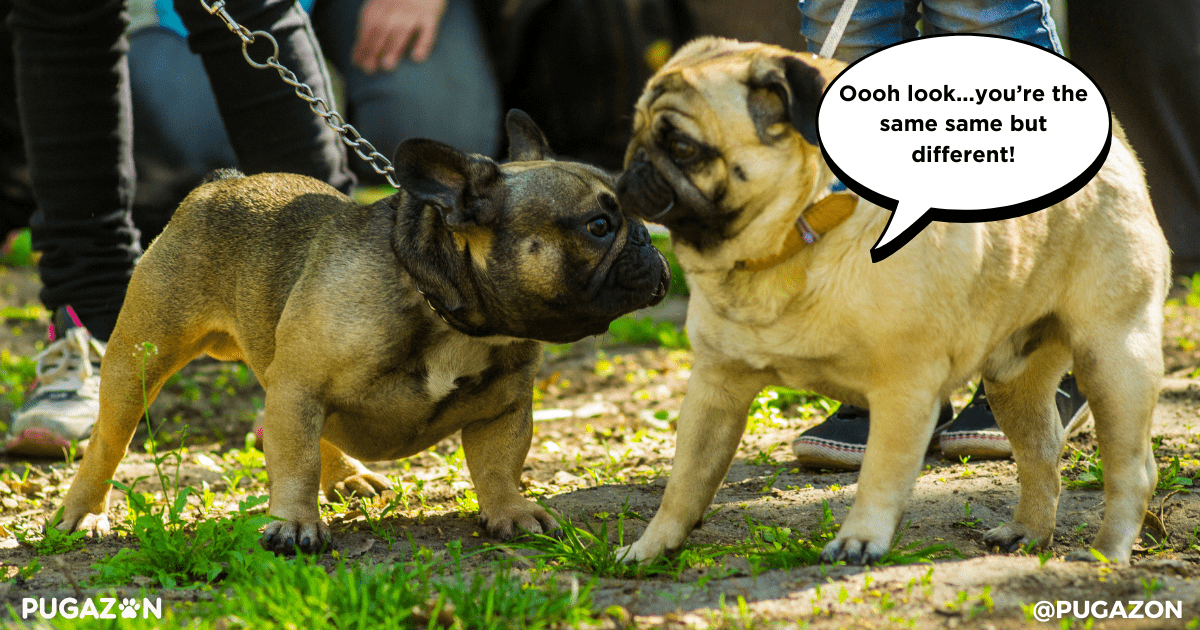
Training your pug to respond appropriately in different real-world situations is crucial for a well-behaved companion. From being around children to interacting with other pets, each situation requires specific strategies to ensure your pug behaves appropriately.
Training Pugs Around Children
Pugs are typically affectionate and great with kids, but it’s important to teach them how to interact safely and calmly with children. Children can sometimes overwhelm pugs with their energy, and pugs need to be taught how to remain calm and gentle.
- Tip: Teach your pug to stay calm when around children by using commands like “sit” or “stay” when kids are nearby. Reward your pug for calm behavior and supervise all interactions.
Pug Socialization Training with Other Dogs
Pugs are generally sociable dogs, but proper socialization is essential to prevent anxiety or aggression when meeting other dogs. Start socializing your pug early by introducing them to friendly dogs in controlled environments.
- Tip: Use positive reinforcement to reward your pug for calm, friendly behavior around other dogs. If your pug shows signs of nervousness or aggression, remove them from the situation and try again later.
Training Pugs for Public Spaces
Public places can be overwhelming for pugs due to the variety of noises, smells, and distractions. Training your pug to remain calm in public spaces is important for both safety and good behavior.
- Tip: Start by taking your pug to quieter public places, gradually working up to busier environments. Practice commands like “sit” and “heel” during walks in public spaces to reinforce good behavior.
Managing Guests with Pug Training
Many pugs get excited when guests arrive, leading to excessive barking or jumping. Teaching your pug to remain calm when people visit will ensure a more peaceful home environment.
- Tip: Train your pug to “sit” or “stay” at the door when guests arrive. You can also redirect their excitement by giving them a chew toy or treat when guests enter the home.
Situation | Training Tip |
Around Children | Use commands like “sit” and reward calm behavior. |
Socializing with Other Dogs | Gradually introduce to new dogs and use rewards. |
Public Spaces | Practice commands in low-distraction environments. |
When Guests Visit | Teach “sit” or “stay” at the door to reduce excitement. |
Pug Training for Obedience and Manners
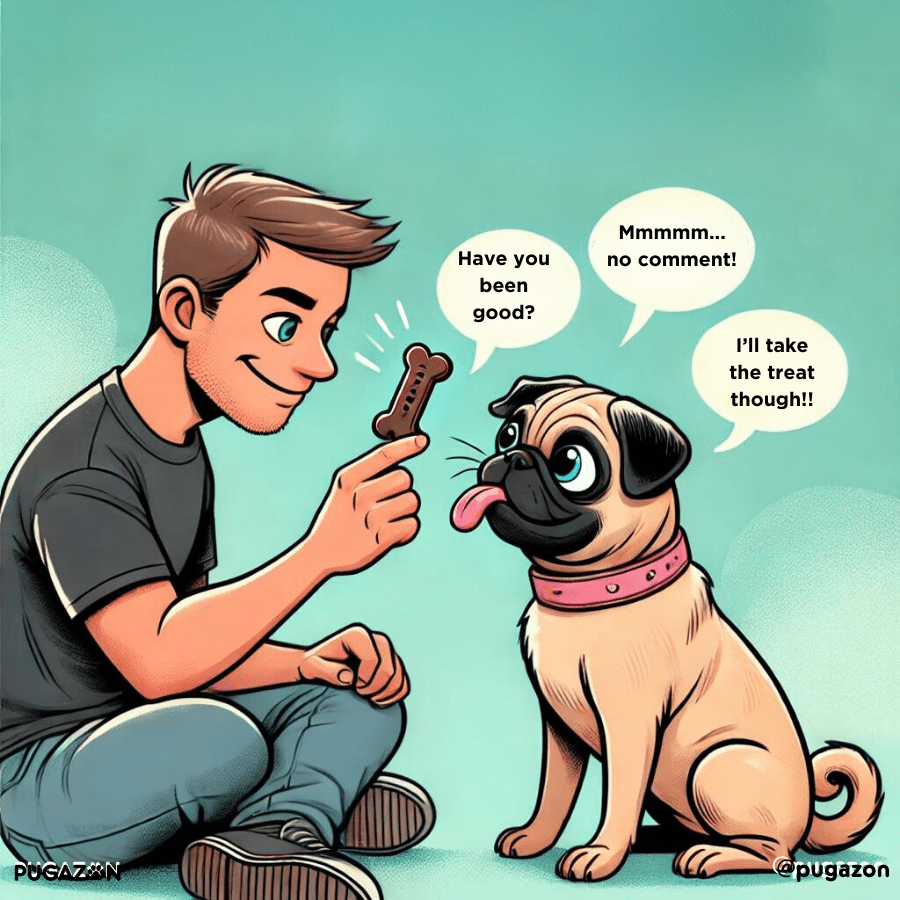
Obedience training is essential for ensuring your pug listens to commands and behaves well in various environments. Pugs are intelligent and eager to please, but they can be easily distracted, making obedience training crucial to managing their behavior.
Teaching Basic Manners in Pug Training
Teaching your pug basic manners—such as not jumping on furniture, not begging at the table, and waiting patiently for meals—creates a well-mannered dog that’s easy to live with.
- Tip: Establish clear boundaries by using commands like “off” for furniture or “wait” during mealtimes. Be consistent with enforcing these rules, and reward your pug for following them.
Daily Obedience Practice in Pug Training
Obedience training should be an ongoing process. Reinforce basic commands during daily activities, such as walks, playtime, or meal times. Regular practice helps cement the training and ensures your pug doesn’t forget what they’ve learned.
- Tip: During walks, practice “heel” and “sit” at stoplights or curbs. Use opportunities like feeding time to practice commands like “wait” and “stay.”
Impulse Control in Pug Training
Pugs can be impulsive, especially when food or exciting stimuli are involved. Teaching impulse control is important to prevent bad behaviors like jumping up or stealing food.
- Tip: Use the “leave it” command to teach your pug to control their impulses around food or toys. Gradually increase the difficulty by adding distractions during training sessions.
Obedience Skill | How to Train |
Basic Manners | Use “off,” “wait,” and enforce boundaries. |
Daily Practice | Reinforce commands during walks, mealtimes, etc. |
Impulse Control | Teach “leave it” for food or toy temptations. |
Always Stay Up to Date
Mastering Leash Training in Pug Training
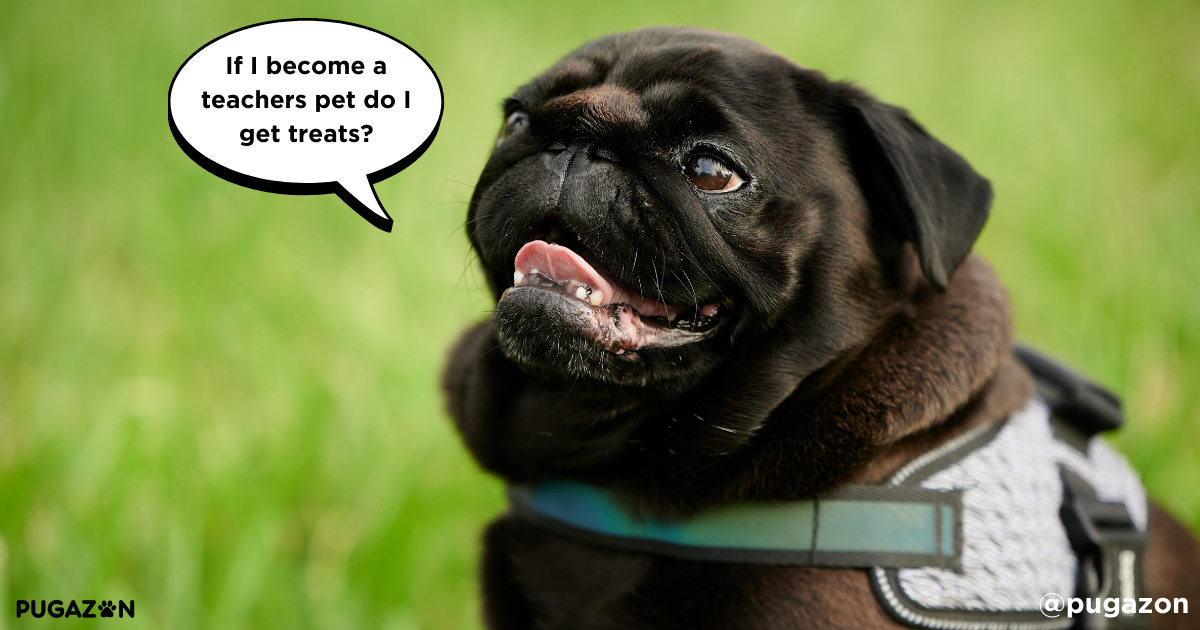
Leash training is one of the most important aspects of owning a pug, especially if you want to enjoy walks without pulling or distractions. Pugs can be stubborn on a leash, so mastering this training is essential for both their safety and your sanity.
Building Comfort with Leash Training for Pugs
Some pugs may be hesitant to wear a leash or harness at first, especially if they’re not used to it. Start by introducing the leash slowly.
- Step 1: Let your pug sniff and explore the leash and harness without putting it on. Use treats and praise to create a positive association.
- Step 2: Once your pug is comfortable, attach the leash and let them walk around the house with it for short periods. Reward them for staying calm.
“Heel” and No-Pull Pug Training Techniques
Pugs have a tendency to pull on the leash, especially if they’re excited by something. Teaching the “heel” command will help them walk calmly beside you.
- Step 1: Start by holding the leash close, ensuring there’s just enough slack for your pug to walk beside you.
- Step 2: When your pug starts pulling, stop walking. Only resume walking once your pug returns to your side. Use the “heel” command when they walk calmly beside you and reward them with treats.
Handling Distractions in Leash Training for Pugs
Pugs are easily distracted by noises, smells, and other dogs. Teaching your pug to focus on you during walks will prevent pulling and darting toward distractions.
- Tip: Use a treat or favorite toy to keep your pug’s attention during walks. Practice commands like “look” to get them to focus on you when distractions arise.
Leash Training Tip | How It Helps |
Introduce the leash slowly | Prevents fear or anxiety toward the leash. |
Teach “heel” for calm walks | Reduces pulling and encourages calm behavior. |
Handle distractions with treats | Keeps your pug focused on you during walks. |
Avoiding Common Pug Training Mistakes
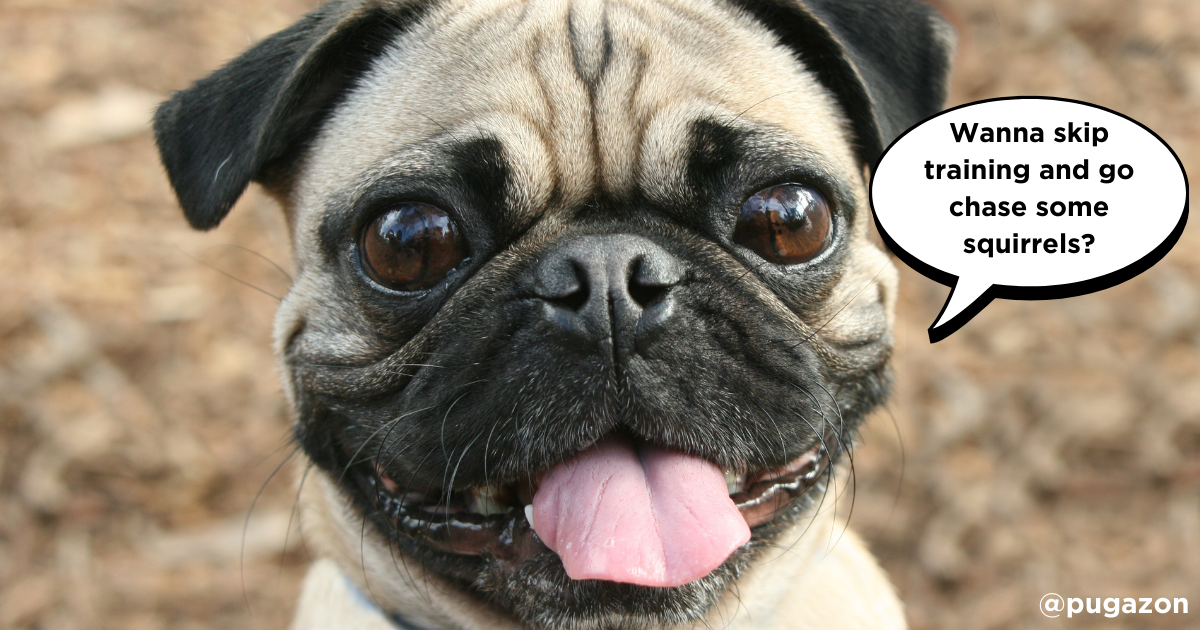
Training a pug can be tricky, and it’s easy to make mistakes that hinder progress. Identifying and avoiding these common mistakes will help ensure that your pug learns effectively and enjoys the training process.
Avoiding Inconsistencies in Pug Training
One of the most common mistakes is using inconsistent commands, which confuses your pug. For example, using “come here” one day and “come” the next can make it difficult for your pug to understand what you want.
- Solution: Stick to one-word commands and use them consistently. Make sure all family members use the same commands to avoid confusion.
Setting Realistic Pug Training Expectations
Pugs may take longer than other breeds to learn commands, especially if they’re being trained later in life. Expecting results too quickly can lead to frustration and may cause setbacks in training.
- Solution: Be patient and keep sessions short. It’s better to have several short training sessions throughout the day than one long, overwhelming session.
Maximizing Positive Reinforcement in Pug Training
Pugs respond best to positive reinforcement. Failing to reward good behavior immediately can lead to slower progress in training.
- Solution: Always have treats ready during training sessions. Praise and reward your pug immediately after they perform a desired behavior.
Mistake | How to Avoid It |
Inconsistent commands | Stick to one-word commands and be consistent. |
Expecting results too quickly | Keep sessions short and be patient. |
Lack of positive reinforcement | Always reward desired behaviors immediately. |
Mental Stimulation and Trick Training in Pug Training
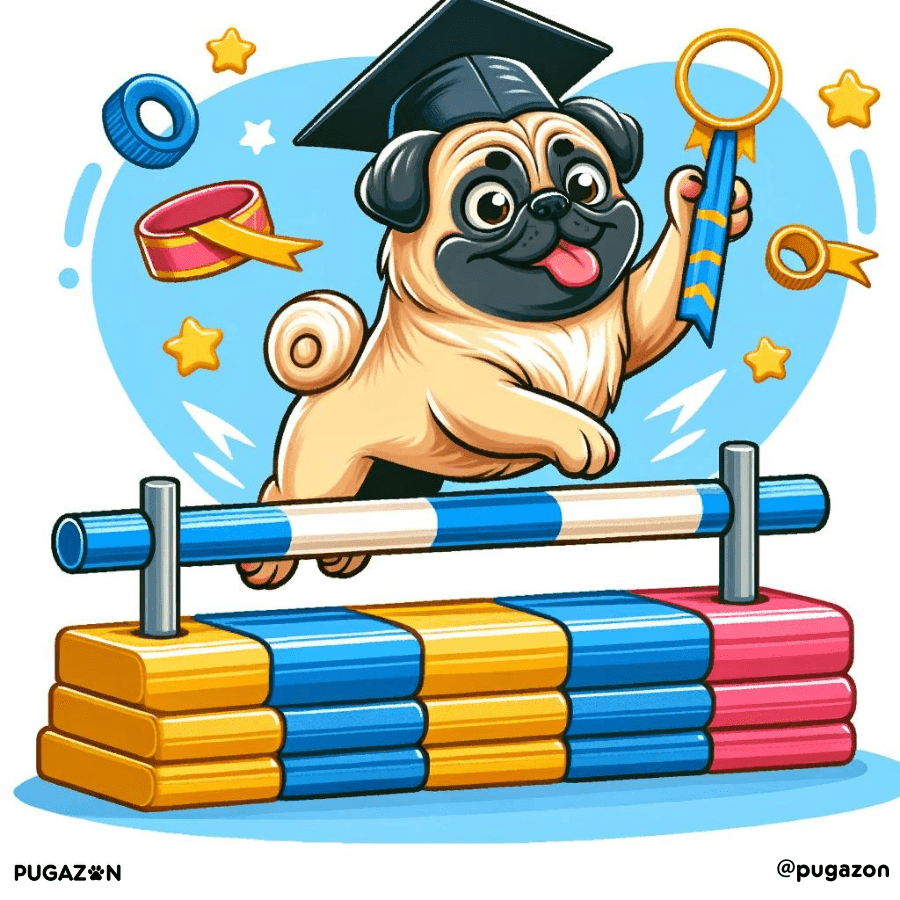
Pugs are intelligent dogs that thrive on mental stimulation. Providing your pug with trick training and interactive activities will not only enhance their obedience but also keep them entertained and well-behaved. Mental stimulation is just as important as physical exercise, especially for a breed like pugs that enjoy problem-solving challenges.
Importance of Mental Stimulation in Pug Training
Mental stimulation helps prevent boredom, which can lead to unwanted behaviors like excessive barking or chewing. It also helps keep your pug’s mind sharp, especially as they age.
- Tip: Incorporate puzzle toys, interactive feeders, and training games into your pug’s daily routine to keep them engaged and focused.
Introducing Fun Tricks in Pug Training
Trick training is a great way to challenge your pug mentally while also reinforcing obedience. Some fun tricks you can teach your pug include:
- Shake Hands: Start by asking your pug to sit. Gently lift one of their paws and say “shake.” Immediately reward them with a treat. Repeat this until your pug offers their paw on their own.
- Spin: Hold a treat in front of your pug’s nose and slowly move it in a circle. As your pug follows the treat, say “spin.” Once they complete the circle, give them the treat and praise.
- Roll Over: Start with your pug in a “down” position. Hold a treat close to their nose and slowly move it toward their shoulder. As they follow the treat, they’ll naturally roll over. Once they do, give them the treat and say “roll over.”
Pug Training Using Puzzle Toys and Interactive Feeders
Puzzle toys and interactive feeders are great ways to mentally stimulate your pug while also rewarding them with treats. These toys challenge your pug to figure out how to get the treat, which engages their problem-solving skills.
- Recommended Puzzle Toy: KONG Classic Dog Toy – Fill this toy with treats or peanut butter to keep your pug entertained while also providing mental stimulation.
- Recommended Interactive Feeder: Outward Hound Fun Feeder – This feeder is designed to slow down eating while stimulating your pug’s mind as they figure out how to get their food.
Trick or Game | How to Teach It |
Shake Hands | Gently lift their paw and reward them with a treat. |
Spin | Lure them with a treat in a circular motion. |
Roll Over | Guide them into rolling over with a treat. |
Advanced Techniques in Pug Training
Once your pug has mastered basic obedience commands and some fun tricks, you can challenge them with advanced training techniques. These can include agility training, advanced tricks, or even certification for therapy work. Advanced training keeps your pug’s mind sharp and their behavior well-rounded.
Agility Training in Pug Training
While pugs are not typically known for agility due to their short legs and stout bodies, they can still enjoy light agility exercises. Agility training helps improve their coordination and keeps them physically active.
- Tip: Set up a small obstacle course in your backyard or living room. Use tunnels, jumps, and weaving poles to create a fun agility course for your pug to navigate. Start slow and use treats to guide them through the course.
Advanced Pug Training Tricks
In addition to basic tricks, you can challenge your pug with more advanced commands like “play dead,” “fetch,” or “speak.” These tricks require more patience but are great for keeping your pug engaged.
- Teaching “Play Dead”: Start with your pug in a “down” position. Hold a treat above their head and move it over to one side, encouraging them to lie on their side. Once they do, say “play dead” and reward them with a treat.
- Teaching “Fetch”: Some pugs love to fetch, while others need a little encouragement. Start by throwing a toy a short distance. When your pug picks it up, call them back and reward them with a treat. Gradually increase the distance of the throw.
Training Pugs for Therapy Roles
Pugs have a calm and affectionate nature, making them great candidates for therapy dog certification. Therapy dogs visit hospitals, schools, and nursing homes to provide comfort and companionship. To become a certified therapy dog, your pug will need to pass obedience tests and exhibit good manners in a variety of situations.
- Tip: Look into local therapy dog certification programs, which often involve a series of tests to assess your pug’s temperament, obedience, and ability to remain calm in public settings.
Advanced Training | How to Teach It or Where to Begin |
Agility Training | Set up a small obstacle course with tunnels and jumps. |
Play Dead | Guide your pug into a lying position using a treat. |
Therapy Dog Certification | Enroll in a local therapy dog training program. |
Creating a Training-Friendly Home for Pugs
A well-organized home environment can significantly improve your pug’s training success. Setting up dedicated spaces for different activities, like crate training, playtime, and rest, ensures that your pug knows what to expect in each area and reduces confusion.
Crate Setup in Pug Training
Crate training is a highly effective way to housebreak your pug and give them a safe space to relax. Choose a quiet corner of your home to place the crate, away from too much noise or activity.
- Tip: Make the crate comfortable with a soft bed and a few favorite toys. Encourage your pug to use the crate as a restful, secure space, rather than as a place of punishment.
Designating a Play Zone
Pugs are playful dogs, and they need a space where they can safely burn off energy. Set up a dedicated play area where your pug can enjoy their toys, puzzles, and interact with family members.
- Tip: Use baby gates or playpens to create a defined area where your pug can play without getting into trouble. Rotate toys regularly to keep them interested.
Designating Training Spaces for Pugs
When training, it’s important to have a calm, distraction-free space where your pug can focus on learning new commands. Choose a quiet room or part of the house for training sessions to ensure your pug isn’t distracted by noises or other pets.
- Tip: Avoid training in high-traffic areas like the kitchen or living room. Instead, choose a quieter spot, like a bedroom or study, where you can focus on your pug without distractions.
Home Setup | Purpose |
Crate Area | Provides a safe, quiet space for rest and housebreaking. |
Play Zone | A dedicated space for play and energy release. |
Calm Training Area | A distraction-free zone for learning new commands. |
Overcoming Stubbornness in Pug Training
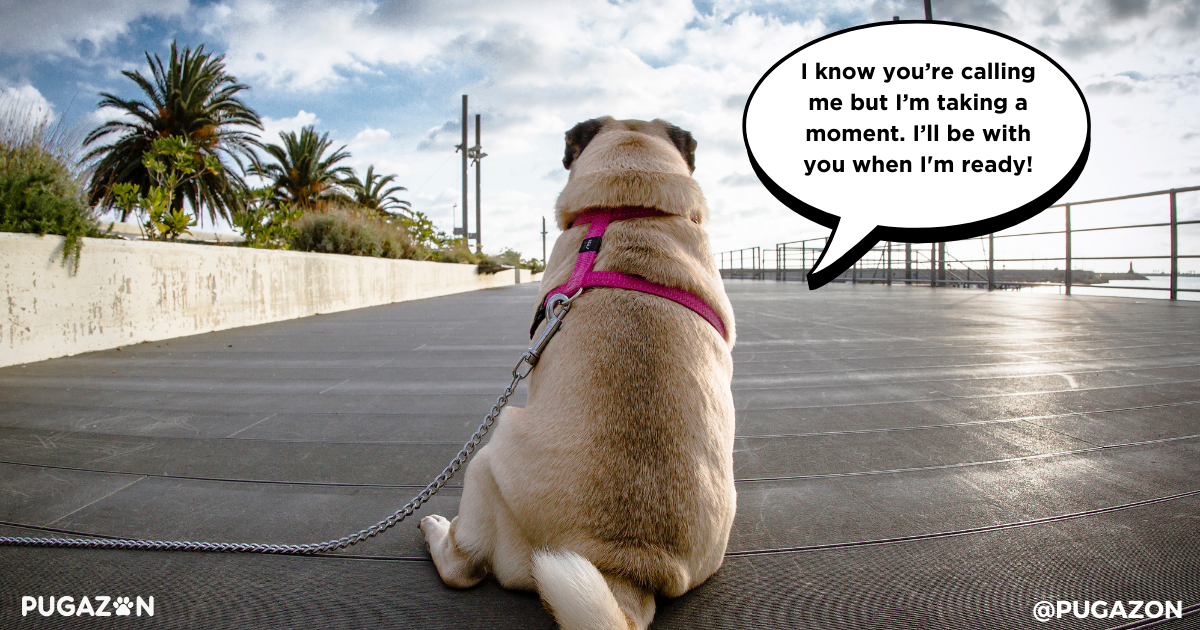
Understanding Stubborn Behavior in Pugs
Pugs may appear stubborn when they’re disinterested in commands or distracted. However, this behavior is often due to a lack of motivation or engagement. Understanding why your pug is acting stubborn is the first step toward correcting it.
Tip: Observe whether your pug is bored, tired, or distracted during training sessions. Adjust the session by incorporating breaks or changing the training environment to re-engage them.
Using High-Value Rewards in Pug Training
Pugs are highly food-motivated, so using high-value treats (something extra special like chicken or cheese) can help you break through their stubbornness. These rewards will motivate them to follow commands, even when they’re being uncooperative.
- Tip: Use these high-value treats sparingly to avoid overfeeding. Reserve them for particularly stubborn moments to regain your pug’s focus.
Short and Fun Pug Training Sessions
If your pug is being stubborn, it might be because they’re getting bored. Pugs have short attention spans, so training sessions should be short, engaging, and fun.
- Tip: Limit each training session to about 10-15 minutes and incorporate play breaks to keep your pug interested and happy. This helps break the monotony and makes training feel like a game.
Be Patient and Consistent
Stubborn behavior is best overcome with patience and consistency. Avoid getting frustrated or punishing your pug, as this can create anxiety and make training more difficult.
- Tip: Stick to a consistent schedule and use positive reinforcement. If your pug is being particularly stubborn, take a break and return to training later.
| Stubborn Behavior | Solution |
| Lack of motivation | Use high-value treats to re-engage them. |
| Boredom during sessions | Keep sessions short and incorporate breaks. |
| Distracted by environment | Change training locations to reduce distractions. |
Pug Training for Dogs with Disabilities or Health Issues
Pugs are prone to specific health issues, such as breathing problems (brachycephalic syndrome), joint issues, and obesity. Training a pug with disabilities or health issues requires modifications to ensure their comfort and safety during training sessions.
Adjusting Pug Training for Breathing Challenges
Due to their flat faces, pugs are prone to breathing difficulties, especially in hot weather or during intense activity. Training should be adjusted to accommodate these limitations.
Tip: Keep training sessions short and take frequent breaks. Avoid training in hot weather, as pugs can easily overheat. Instead, opt for cooler, early morning or evening sessions.
Pug Training Equipment and Tools
Having the right equipment and tools can make pug training easier and more effective. Below are some essential products that can help streamline the training process.
Training Collars and Harnesses
Pugs have delicate necks due to their brachycephalic (flat-faced) nature, so using a proper harness rather than a collar is important for leash training. A harness reduces pressure on their neck and makes it easier to control pulling behavior.
- Recommended Product: Ruffwear Front Range Dog Harness
This comfortable, adjustable harness provides excellent support for pugs without putting pressure on their necks.
Long Leashes for Recall Training
Recall training is an essential part of any pug’s training, especially if you want them to enjoy off-leash activities. A long leash allows your pug to wander while you maintain control during the early stages of recall training.
- Recommended Product: Hi Kiss Long Training Leash
This durable, 30-foot leash is perfect for recall training and gives your pug enough room to explore while you practice the “come” command.
Treat Pouches
Treat pouches are a must-have for quick access to rewards during training sessions. Having treats on hand makes positive reinforcement more effective.
- Recommended Product: Paw Lifestyles Dog Treat Training Pouch
This pouch attaches to your waist or belt, keeping treats easily accessible during training.
Clickers for Positive Reinforcement
Clicker training is a popular method of marking desired behaviors with a consistent sound before offering a treat. The sound of the clicker helps your pug associate the behavior with a reward.
- Recommended Product: PetSafe Clik-R Dog Training Clicker
This easy-to-use clicker provides a clear, consistent sound, helping you reinforce commands effectively.
Interactive Toys for Mental Stimulation
Interactive toys are great for keeping your pug engaged and mentally stimulated during training breaks. These toys can help reinforce behaviors learned during training and prevent boredom.
- Recommended Product: KONG Classic Dog Toy
Fill the KONG toy with treats or peanut butter to keep your pug entertained between training sessions.
Training Tool | How It Helps |
Harness | Prevents pressure on pug’s delicate neck. |
Long Leash | Provides space for recall training. |
Treat Pouch | Keeps treats accessible for positive reinforcement. |
Clicker | Reinforces positive behavior with a consistent sound. |
Interactive Toy | Keeps your pug mentally stimulated during breaks. |
FAQs About Training Pugs
The time it takes to train a pug varies depending on their age, temperament, and consistency in training. On average, it can take 3-6 months for a pug to fully grasp basic commands and routines. Puppies tend to learn faster, while older pugs may take a bit more time, especially if they have ingrained habits. The key to successful training is patience and consistency.
Pugs can be a bit more challenging to train due to their stubborn nature. While they are intelligent and eager to please, they can also be easily distracted. However, with positive reinforcement and consistency, pugs can learn commands and tricks just as well as other breeds.
Consistency is key when potty training a pug. Establish a regular schedule for bathroom breaks, especially after meals, naps, and playtime. Crate training can also be very effective in teaching bladder control. Be patient, as pugs may take longer to fully understand the concept of potty training.
Excessive barking can be curbed by identifying the trigger (e.g., strangers, boredom, or anxiety). Once the trigger is identified, use commands like “quiet” or “enough” to stop the behavior. Reward your pug when they stop barking. Additionally, ensuring your pug has enough mental stimulation and physical activity can reduce boredom-related barking.
While pugs can be trained to walk off-leash, it’s important to be cautious. Pugs are curious and may wander off if something catches their interest. Start with basic recall training and practice in enclosed areas before trying off-leash walks in open spaces. Always keep treats handy for positive reinforcement.
Low-calorie treats are ideal for pug training, as pugs are prone to obesity. Look for small, healthy treats like Zuke’s Mini Naturals or break larger treats into smaller pieces. Always adjust meal portions if you’re using a lot of treats during training sessions to avoid weight gain.
Leash pulling can be corrected by teaching your pug the “heel” command. When your pug starts to pull, stop walking and wait until they return to your side. Reward them with a treat when they walk calmly beside you. Practice this consistently during walks to reinforce the behavior.
Older pugs can absolutely be trained, though it may take a bit more patience. Start with short, simple training sessions and focus on one command at a time. Use plenty of positive reinforcement, and be mindful of any health issues that may affect their ability to perform certain tasks.
Training your pug to remain calm around guests requires desensitizing them to new people. Start by having guests ignore your pug when they first arrive. Use commands like “sit” or “stay” to keep your pug in one place, and reward calm behavior with treats. Over time, your pug will learn that staying calm around guests results in rewards.
Hiring a professional trainer can be beneficial if you’re struggling with specific behaviors or if your pug isn’t responding well to your efforts. A professional trainer can provide tailored advice and help address challenging behaviors more effectively. However, with consistency and the right techniques, most pug owners can successfully train their pugs on their own.


